Burn surface area estimation. Estimating Burn Surface Area in Children: Palm vs. Full Hand Method
How accurate is using a child’s palm to estimate burn surface area. What is the recommended method for determining total body surface area affected by burns in pediatric patients. Can the entire palmar surface of a child’s hand provide a more precise estimate of burn percentage.
The Importance of Accurate Burn Surface Area Estimation in Pediatric Patients
Accurately estimating the surface area affected by burns is crucial for proper evaluation and treatment of burn injuries in children. The total body surface area (TBSA) involved in a burn helps determine the severity of the injury and guides important treatment decisions like fluid resuscitation. However, estimating burn size can be challenging, especially in pediatric patients whose body proportions differ from adults.
Traditionally, healthcare providers have been taught that a patient’s palm represents approximately 1% of their total body surface area. This “rule of palm” has been widely used as a quick method to estimate burn size. However, research suggests this may not be accurate, particularly for children.
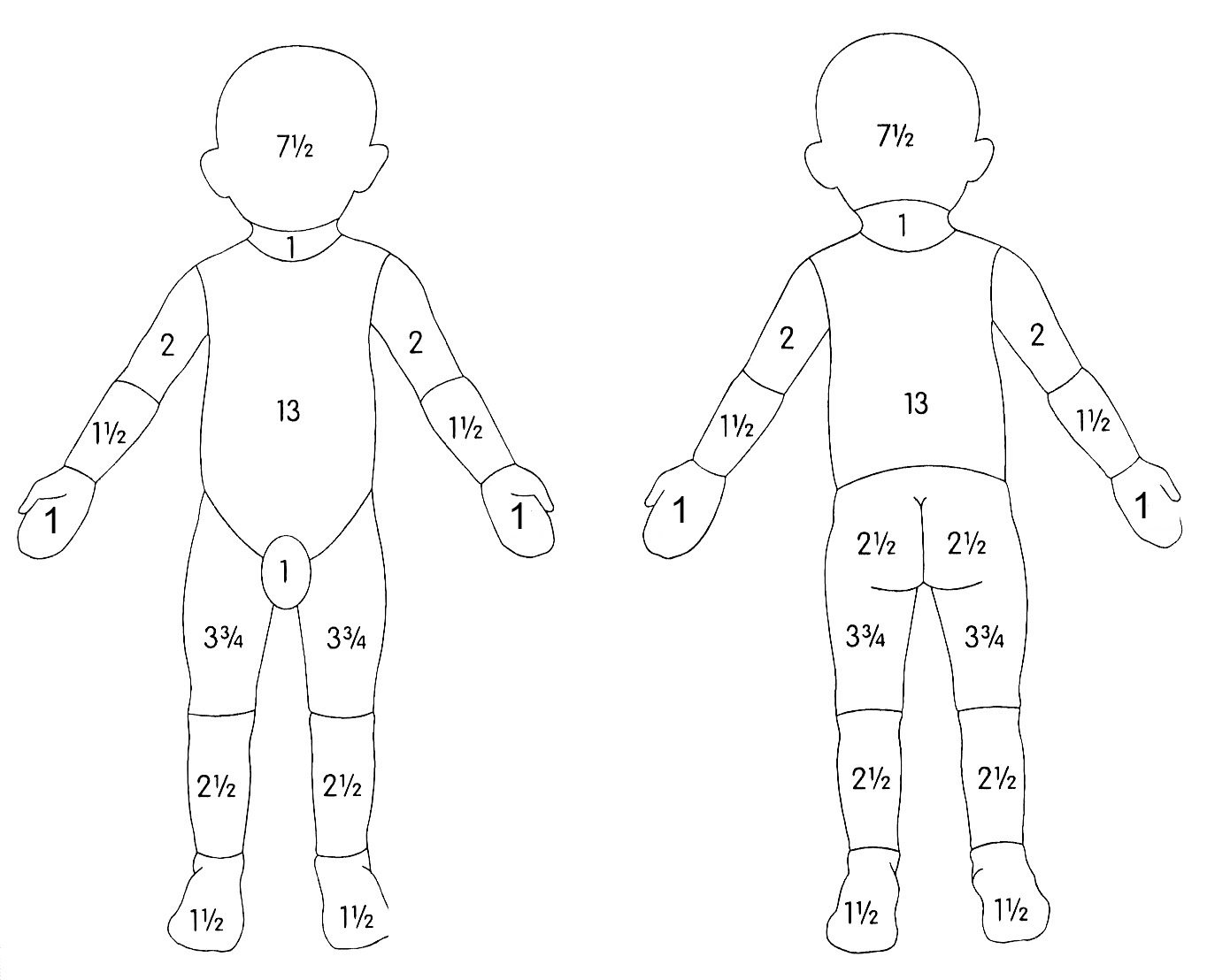
Comparing Palm vs. Full Hand Methods for Burn Size Estimation
A study published in the journal Pediatric Emergency Care aimed to determine whether using just the palm or the entire palmar surface of a child’s hand provides a more accurate estimate of 1% TBSA. The researchers conducted a prospective study with a convenience sample of 91 children.
Study Methodology
- Researchers determined each child’s total body surface area using height, weight, and standard nomograms
- Photocopies were made of each child’s hand to measure the surface area of:
- The palm only
- The entire palmar surface of the hand (palm plus fingers)
- These hand measurements were compared to the calculated total body surface area
Key Findings
The study revealed some important differences between the palm-only and full hand methods:
- The entire palmar surface (palm plus fingers) represented a mean of 0.94% of TBSA (95% CI: 0.93-0.97%)
- The palm alone represented a mean of 0.52% of TBSA (95% CI: 0.51-0.53%)
These results indicate that the full palmar surface of a child’s hand much more closely approximates 1% of TBSA compared to just the palm. Using only the palm would likely lead to a significant underestimation of burn size in pediatric patients.

Clinical Implications for Pediatric Burn Assessment
The findings of this study have important implications for how healthcare providers should estimate burn surface area in children:
- Using the entire palmar surface of the hand (including fingers) provides a more accurate estimate of 1% TBSA
- The traditional “rule of palm” method may lead to underestimation of burn size by nearly 50% in pediatric patients
- More precise burn size estimation can lead to better-tailored treatment plans and fluid resuscitation protocols
Is the full hand method universally applicable to all pediatric age groups? While this study provides valuable insights, further research may be needed to confirm if the results hold true across different pediatric age ranges, from infants to adolescents. Body proportions change throughout childhood, which could potentially impact the accuracy of this method in certain age groups.
Other Methods for Estimating Burn Surface Area in Children
While the full hand method offers improved accuracy over the palm-only approach, it’s important to note that other methods exist for estimating burn surface area in pediatric patients:
:max_bytes(150000):strip_icc()/degrees-of-burns-1298906_v2-b34a363d24824c8b935448fe774a753d.png)
Lund-Browder Chart
The Lund-Browder chart is considered the gold standard for burn size estimation in children. It takes into account the changing body proportions as children grow, providing age-specific percentages for different body regions.
Rule of Nines
The Rule of Nines divides the body into sections that each represent 9% (or a multiple of 9%) of the total body surface area. However, this method is less accurate in children than adults due to their different body proportions.
Digital Planimetry
More advanced techniques like digital planimetry use computer software to analyze photographs of burns and calculate the affected surface area. While potentially very accurate, this method may not be readily available in all clinical settings.
How do these methods compare in terms of accuracy and ease of use in emergency situations? Each method has its strengths and limitations. The full hand method offers a good balance of improved accuracy over the palm-only approach while still being quick and easy to use in urgent situations.

Potential Sources of Error in Burn Size Estimation
Even with improved methods, several factors can contribute to errors in estimating burn surface area:
- Irregular burn shapes that don’t conform neatly to anatomical regions
- Difficulty assessing depth of burns, particularly with partial thickness injuries
- Variations in individual body proportions that may not match standardized charts
- Burn progression over time, potentially increasing the affected surface area
- Observer variability and differences in experience levels among healthcare providers
How can healthcare providers minimize these potential sources of error? Regular training, use of standardized assessment tools, and serial evaluations of burn injuries can help improve accuracy and consistency in burn size estimation.
The Impact of Accurate Burn Size Estimation on Treatment
Precise determination of the total body surface area affected by burns is critical for several aspects of patient care:
Fluid Resuscitation
The amount of fluid required for resuscitation in severe burns is directly related to the percentage of TBSA affected. Overestimation of burn size can lead to excessive fluid administration, potentially causing complications like pulmonary edema. Underestimation may result in inadequate fluid resuscitation and subsequent organ dysfunction.

Nutritional Support
Burn injuries significantly increase a patient’s metabolic demands. Accurate assessment of burn size helps determine the appropriate caloric and protein requirements for optimal healing.
Wound Care and Grafting Decisions
The extent of burns influences decisions about topical treatments, dressing choices, and the potential need for skin grafting procedures.
Triage and Transfer Decisions
Burn size is a key factor in determining whether a patient requires treatment at a specialized burn center. Accurate estimation helps ensure patients receive the appropriate level of care.
Given these critical treatment implications, how can healthcare systems ensure consistent and accurate burn size estimation across different providers and care settings? Implementing standardized training programs and assessment protocols can help achieve more uniform and reliable burn size estimates.
Future Directions in Pediatric Burn Assessment
As medical technology advances, new methods for burn assessment are emerging:
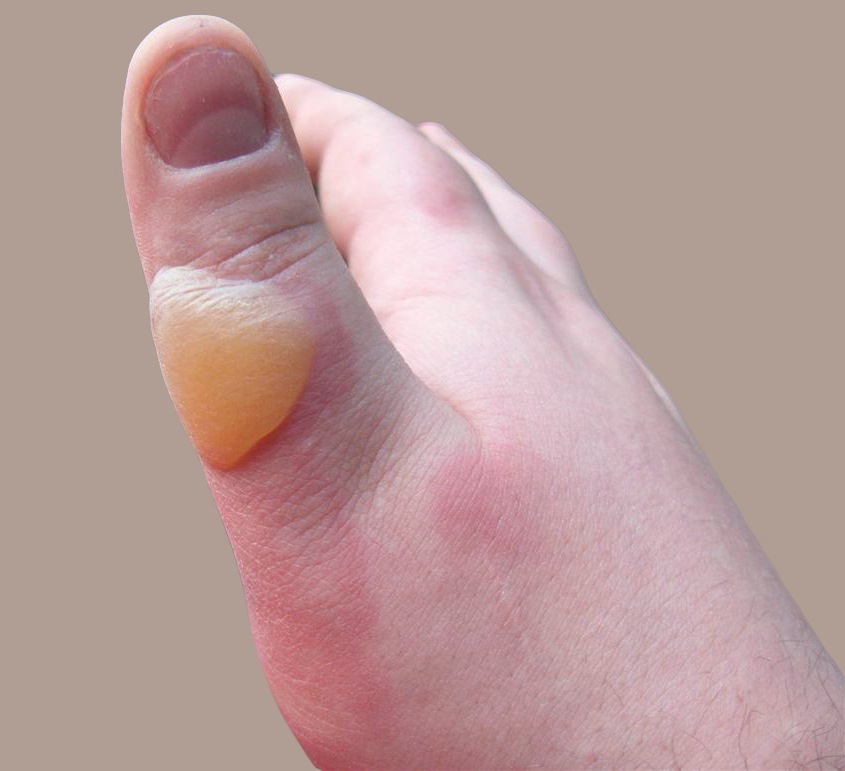
- 3D scanning technology to create detailed digital models of burn injuries
- Artificial intelligence algorithms to analyze burn photographs and provide automated TBSA calculations
- Infrared imaging to better assess burn depth and potential progression
- Biomarkers and genetic tests to predict individual healing potential and complication risks
Using the hand to estimate the surface area of a burn in children
Save citation to file
Format:
Summary (text)PubMedPMIDAbstract (text)CSV
Add to Collections
- Create a new collection
- Add to an existing collection
Name your collection:
Name must be less than 100 characters
Choose a collection:
Unable to load your collection due to an error
Please try again
Add to My Bibliography
- My Bibliography
Unable to load your delegates due to an error
Please try again
Your saved search
Name of saved search:
Search terms:
Test search terms
Email:
(change)
Which day?
The first SundayThe first MondayThe first TuesdayThe first WednesdayThe first ThursdayThe first FridayThe first SaturdayThe first dayThe first weekday
Which day?
SundayMondayTuesdayWednesdayThursdayFridaySaturday
Report format:
SummarySummary (text)AbstractAbstract (text)PubMed
Send at most:
1 item5 items10 items20 items50 items100 items200 items
Send even when there aren’t any new results
Optional text in email:
Create a file for external citation management software
. 1997 Aug;13(4):254-5.
1997 Aug;13(4):254-5.
doi: 10.1097/00006565-199708000-00003.
T R Nagel
1
, J E Schunk
Affiliations
Affiliation
- 1 Emergency Department, Southwestern Texas Methodist Hospital, San Antonio, USA.
PMID:
9291511
DOI:
10.1097/00006565-199708000-00003
T R Nagel et al.
Pediatr Emerg Care.
1997 Aug.
. 1997 Aug;13(4):254-5.
doi: 10.1097/00006565-199708000-00003.
Authors
T R Nagel
1
, J E Schunk
Affiliation
- 1 Emergency Department, Southwestern Texas Methodist Hospital, San Antonio, USA.

PMID:
9291511
DOI:
10.1097/00006565-199708000-00003
Abstract
Objective:
Estimation of the surface area involved is vital to evaluation and treatment of burns. Common teaching suggests the palm approximates 1% of the total body surface area (TBSA). However, early century literature suggests the palmar surface of the entire hand approximates 1% of the TBSA. We sought to determine whether the palm or the entire palmar surface of the hand approximates 1% TBSA in children.
Design:
A prospective, convenience sample.
Materials and methods:
Using height, weight, and standard nomograms, body surface area was determined. A photocopy of the hand was used to determine the surface area of the palm and the entire palmar surface of the hand.
A photocopy of the hand was used to determine the surface area of the palm and the entire palmar surface of the hand.
Results:
In 91 children, the mean percent of the TBSA represented by the entire palmar surface was 0.94% (95% confidence interval (C.I.) 0.93-0.97), and the mean percent of the TBSA represented by the palm was 0.52% (95% C.I. 0.51-0.53).
Conclusion:
The entire palmar surface of a child’s hand more closely approximates 1% TBSA, while the palm approximate 0.5% TBSA.
Similar articles
Determination of hand and palm area as a ratio of body surface area in Indian population.
Agarwal P, Sahu S.
Agarwal P, et al.
Indian J Plast Surg. 2010 Jan;43(1):49-53. doi: 10.4103/0970-0358.63962.
Indian J Plast Surg. 2010.
2010.PMID: 20924450
Free PMC article.Planimetry study of the percent of body surface represented by the hand and palm: sizing irregular burns is more accurately done with the palm.
Sheridan RL, Petras L, Basha G, Salvo P, Cifrino C, Hinson M, McCabe M, Fallon J, Tompkins RG.
Sheridan RL, et al.
J Burn Care Rehabil. 1995 Nov-Dec;16(6):605-6. doi: 10.1097/00004630-199511000-00008.
J Burn Care Rehabil. 1995.PMID: 8582938
Utility of palm and hand surface area in approximating burn extent in Burundian adults and children.
Wendler CB, Irakoze V.
Wendler CB, et al.
Burns. 2022 Mar;48(2):456-458. doi: 10.1016/j.burns.2021.02.003. Epub 2021 Feb 20.
Burns. 2022.PMID: 34933750
The surface area of the hand and the palm for estimating percentage of total body surface area: results of a meta-analysis.

Rhodes J, Clay C, Phillips M.
Rhodes J, et al.
Br J Dermatol. 2013 Jul;169(1):76-84. doi: 10.1111/bjd.12290.
Br J Dermatol. 2013.PMID: 23448271
Review.
Emergent burn care.
Harvey JS, Watkins GM, Sherman RT.
Harvey JS, et al.
South Med J. 1984 Feb;77(2):204-14. doi: 10.1097/00007611-198402000-00019.
South Med J. 1984.PMID: 6367073
Review.
See all similar articles
Cited by
3D PED BURN app: A precise and easy-to-use pediatric 3D burn surface area calculation tool.
Meevassana J, Sumonsriwarankun P, Suwajo P, Nilprapha K, Promniyom P, Iamphongsai S, Pungrasmi P, Jindarak S, Kangkorn T, Angspatt A.
Meevassana J, et al.
Health Sci Rep. 2022 Jun 16;5(4):e694. doi: 10.1002/hsr2.694. eCollection 2022 Jul.
2022 Jun 16;5(4):e694. doi: 10.1002/hsr2.694. eCollection 2022 Jul.
Health Sci Rep. 2022.PMID: 35755413
Free PMC article.Expert consensus on the prevention and first-aid management of burns in children.
Pediatric Disaster Branch of Chinese Pediatric Society of Chinese Medical Association; Pediatric Branch of Chinese People’s Liberation Army (Zheng C-Z, Email: [email protected]).
Pediatric Disaster Branch of Chinese Pediatric Society of Chinese Medical Association, et al.
Zhongguo Dang Dai Er Ke Za Zhi. 2021 Dec 15;23(12):1191-1199. doi: 10.7499/j.issn.1008-8830.2109026.
Zhongguo Dang Dai Er Ke Za Zhi. 2021.PMID: 34911600
Free PMC article.Chinese, English.
Technical and Medical Aspects of Burn Size Assessment and Documentation.
Giretzlehner M, Ganitzer I, Haller H.

Giretzlehner M, et al.
Medicina (Kaunas). 2021 Mar 5;57(3):242. doi: 10.3390/medicina57030242.
Medicina (Kaunas). 2021.PMID: 33807630
Free PMC article.Review.
Product of Investigator Global Assessment and Body Surface Area (IGAxBSA): A practice-friendly alternative to the Eczema Area and Severity Index to assess atopic dermatitis severity in children.
Suh TP, Ramachandran D, Patel V, Jackson KL, Rangel SM, Fishbein AB, Paller AS.
Suh TP, et al.
J Am Acad Dermatol. 2020 May;82(5):1187-1194. doi: 10.1016/j.jaad.2020.01.023. Epub 2020 Jan 21.
J Am Acad Dermatol. 2020.PMID: 31972257
Free PMC article.Paediatric burn and scald management in a low resource setting: A reference guide and review.
Broadis E, Chokotho T, Borgstein E.

Broadis E, et al.
Afr J Emerg Med. 2017;7(Suppl):S27-S31. doi: 10.1016/j.afjem.2017.06.004. Epub 2017 Sep 22.
Afr J Emerg Med. 2017.PMID: 30505671
Free PMC article.Review.
See all “Cited by” articles
MeSH terms
Cite
Format:
AMA
APA
MLA
NLM
Send To
Estimating the Size of a Burn
Skip to main navigation
Skip to main content
Skip to footer
For
Medicare
For
Providers
For
Brokers
For
Employers
Español
For Individuals & Families:
For Individuals & Families
Medical
Dental
Other Supplemental
Explore coverage through work
How to Buy Health Insurance
Types of Dental Insurance
Open Enrollment vs.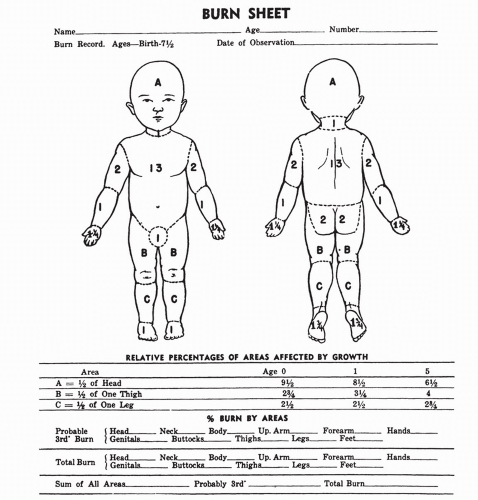 Special Enrollment
Special Enrollment
See all topics
Shop for Medicare plans
Member Guide
Find a Doctor
Log in to myCigna
HomeKnowledge CenterWellness Library
Estimating the Size of a Burn
Overview
You can quickly estimate the size of a burn by using the “rule of nines.” This method divides the body’s surface area into percentages.
Estimating burn size in adults
See a picture of the “rule of nines” for adults.
- The front and back of the head and neck equal 9% of the body’s surface area.
- The front and back of each arm and hand equal 9% of the body’s surface area.

- The chest equals 9% and the stomach equals 9% of the body’s surface area.
- The upper back equals 9% and the lower back equals 9% of the body’s surface area.
- The front and back of each leg and foot equal 18% of the body’s surface area.
- The groin area equals 1% of the body’s surface area.
Estimating burn size in babies and young children
See a picture of the “rule of nines” for babies and young children.
- The front and back of the head and neck are 21% of the body’s surface area.
- The front and back of each arm and hand are 10% of the body’s surface area.
- The chest and stomach are 13% of the body’s surface area.
- The back is 13% of the body’s surface area.

- The buttocks are 5% of the body’s surface area.
- The front and back of each leg and foot are 13.5% of the body’s surface area.
- The groin area is 1% of the body’s surface area.
The “rule of palm” is another way to estimate the size of a burn. The palm of the person who is burned (not fingers or wrist area) is about 1% of the body. Use the person’s palm to measure the body surface area burned.
It can be hard to estimate the size of a burn. If you think a burn is a certain size but you are unsure, it is best to discuss the size of the burn with your doctor.
This information does not replace the advice of a doctor. Healthwise, Incorporated, disclaims any warranty or liability for your use of this information. Your use of this information means that you agree to the Terms of Use. Learn how we develop our content.
Learn how we develop our content.
To learn more about Healthwise, visit Healthwise.org.
© 1995-2023 Healthwise, Incorporated. Healthwise, Healthwise for every health decision, and the Healthwise logo are trademarks of Healthwise, Incorporated.
Related Links
Burns and Electric Shock
<cipublic-spinner variant=”large”><span>Loading…</span></cipublic-spinner>Methods for determining the area of the burn in percent
The correct determination of the area of the burn is one of the mandatory criteria for assessing the condition of the victim. Depending on the size of the damage, determine the appropriate treatment regimen. In burn medicine (combustiology), there are 4 stages of injury – redness, blisters, necrosis and charring of tissues. Extensive wounds are dangerous with life-threatening complications – shock, sepsis, intoxication.
Contents
- Why Calculate Burn Surface Area
- Methods for determining the area of a burn
- Hundred’s rule
- Glumov’s method, or the rule of the palm
- Wallace’s method, or the rule of nines
- Vilyavin’s method
- Postnikov’s method
- Other methods
- How the area of the burn affects development burn disease
- Complications of extensive burns
9000 7 Dolinin method
Why do we need to calculate the surface area of the burn
When making a diagnosis, the combustiologist evaluates the severity of the burn by its area and depth. With symptoms of burn disease, 2/3 of patients develop a shock condition that requires timely treatment. Various prognostic methods are used to predict further therapy and possible complications.
With symptoms of burn disease, 2/3 of patients develop a shock condition that requires timely treatment. Various prognostic methods are used to predict further therapy and possible complications.
The Injury Severity Index (ISI) is one of the most well-known methods for assessing the condition of a victim. When calculated, each percentage of the burnt area gives from 1 to 4 points for the depth of damage. For example, damage to the respiratory tract with preservation of respiratory function – 15 points, with respiratory failure – 30 points, etc.
Forecast of survival taking into account the value of ITP:
- less than 30 points – favorable;
- up to 60 points – conditionally favorable;
- up to 90 points – doubtful;
- from 91 points – unfavorable.
According to the numerical value of the ITP, the victims are assigned to a certain group. Each group has its own treatment options.
When calculating the size of the burn, patients are assigned to one of the following categories:
- seriously injured – at least 20% of the body is damaged, deep burns are found on 10% of the skin, respiratory organs are affected;
- victims of moderate severity – together with superficial injuries, up to 20% of the body was burned, of which only 9-10% wounds are deep;
- lightly wounded – up to 15% of the body burned, not more than 5% are deep burns;
- agonizing victims – affected from 60% of the body, of which 50% are burns of 3 or 4 degrees.

The calculation of the size of wounds is one of the criteria for an adequate assessment of the condition of the victims. If the damage is local and shallow, limited to local therapy. Patients with extensive injuries are subject to hospitalization.
In case of mass injuries, first pre-hospital care is provided to victims with a large amount of injuries with a favorable prognosis of survival.
Inpatient treatment is indicated for patients with burn disease. It manifests itself if:
- the lesions are superficial, but occupy more than 30% of the surface of the skin;
- burns are deep and occupy 10% in adults or 5% in children.
Burn injury is not limited to local symptoms, skin or mucosal wounds. This is a systemic reaction of the body to superficial and deep wounds. An adequate assessment of a person’s condition is possible with the correct calculation of the magnitude of lesions.
Methods for determining the area of a burn
Various methods for determining the area of burns are used in combustiology. Conventionally, they are divided into three categories – calculated, schematic and instrumental. Calculation methods are used for the initial assessment of the extent of wounds at the scene. To determine the further tactics of therapy, the magnitude of the damage is determined more accurately in the conditions of the burn center.
Conventionally, they are divided into three categories – calculated, schematic and instrumental. Calculation methods are used for the initial assessment of the extent of wounds at the scene. To determine the further tactics of therapy, the magnitude of the damage is determined more accurately in the conditions of the burn center.
Hundred’s rule
This is an indicator of the severity of damage to the skin, which is obtained by summing the absolute magnitude of the wounds and the age of the victim. Immediately, at the scene, it is almost impossible to determine the severity of the damage. Therefore, to assess the condition of the victims, the rule of hundreds is used.
Interpretation of results:
- Group 1 (heavily burned). More than 60% of the body is affected, of which 40% are burns of the 3rd or 4th degree with damage to the ENT organs. The prognostic indicator according to the rule of hundreds is equal to or greater than 100. The prognosis of survival for this category of patients is unfavorable.

- 2 group (medium-heavy burnt). ENT organs and 20-50% of the body are affected, of which 10-40% are deep injuries. The survival index is in the range of 80-100 – the prognosis is doubtful.
- Group 3 (light burnt). Up to 20% of the body is affected, only 10% of the burns are deep. Respiratory organs are not damaged, respiratory function is not disturbed. The index according to the rule of hundreds is equal to or less than 80 – the forecast is favorable.
If the area of wounds of 3 and 4 degrees exceeds 35%, symptomatic therapy is carried out. It is almost impossible to cure patients with such injuries.
Glumov’s method, or the palm rule
This method was first proposed by I. Glumov in 1953. According to this rule, the size of the palm of the victim approximately corresponds to 1% of the surface of the skin. Therefore, the palm is taken as a unit of measurement in determining the extent of the injury.
Using the Glumov method, it is convenient to calculate the area of burns in adults.
Wallace’s method, or the rule of nines
The method was proposed by L. Wallace in 1951. This is one simple way to calculate the extent of an injury. Its essence lies in the division of the surface of various parts of the body into zones with an area of 9% or 18%:
- feet and lower legs – 9%;
- inner and outer thighs – 9%;
- abdomen – 9%;
- one hand – 9%;
- chest – 9%;
- head and neck area – 9%;
- genitals and groin – 1%;
- back of the body – 18%.
The burn area according to the rule of nines is measured as a percentage and is suitable for assessing the condition of adults. In patients under 16 years of age, these proportions will be very different. For example, their neck and head area occupies about 21% of the skin surface.
Vilyavin’s method
Vilyavin’s method – a schematic representation of the victim’s body on scale-coordinate paper. Burns of different depths are indicated by different colors:
- first degree – yellow;
- second – red;
- third – blue;
- fourth – black.

The squares on Vilyavin’s map are divided so that they correspond to the area of the victim’s body.
Postnikov’s method
Calculation of the area of injured skin by Postnikov’s method takes a lot of time. But with its help it is possible to accurately determine the extent of burns. Postnikov suggested applying sterile gauze to the wounds of the victims. The contours of the lesions are marked on it, after which forms are cut out of gauze and applied to graph paper. The squares calculate the area of the burn as a percentage.
Table for calculating the burn area according to the Postnikov method:
| Wound area, cm 2 | Percentage of the total body area 0 | 0.6 |
| 5000 | 31.0 | |
| 10000 | 62.0 | |
| 12000 | 75.0 |
This method for determining the extent of burns was proposed in 1957.
Postnikov’s scheme is not used in the initial assessment of the condition of those burned at the scene.
Dolinin method
In 1983 V.A. Dolinin proposed a quick calculation of the area of injured skin using a special stamp. It is a rubber blank of two parts:
- silhouette of the front part of the body – contains 51 sections;
- silhouette of the back – consists of 49 sections.
Each of the indicated areas corresponds to 1% of the skin surface. By sketching burns with solid lines, their area is determined.
The Dolinin method is often used when planning plastic surgeries. On rubber stamps, operated areas and areas of donor sites for skin transplantation are painted over. During the rehabilitation period, the combustiologist notes the results of surgical treatment, the length of the resulting scars.
Other methods
The fastest and most accurate methods for determining the absolute magnitude of an injury have been put into practice. In an emergency, the following are used to calculate the area of burned skin:
In an emergency, the following are used to calculate the area of burned skin:
- The Land and Browder Scheme is a system for calculating the size of burn wounds in children. It takes into account age-related changes in the area of individual parts of the body. In patients under 1 year of age, the neck and head area occupies 21%, the hips – 5.5%, and the back of the body – up to 16% of the total skin area.
- Ariev method – graphical determination of the magnitude of the injury. On the workpiece, sketches are painted over with different inks, depending on the severity of the damage. During therapy, the drawing is corrected, new data is entered into the already created graphic picture. This method is used relatively infrequently, as there are no symbols for the lateral surface of the body in the figure.
In a hospital, the area of burns is measured instrumentally. For this, sterile film blanks are used. They are superimposed on the affected areas. The burn zone is marked on the measuring grid.
The burn zone is marked on the measuring grid.
The severity of injuries in children is determined using silhouette diagrams. According to the area of burned areas, taking into account the traumatic factor, the most adequate treatment regimens are determined.
How the area of the burn affects the development of burn disease
Burn disease is the victim’s response to injury. The larger the affected area, the more likely the negative effects. Burn disease in patients of different age categories occurs with different values of damage:
- children – 5%;
- old people – 10%;
- young people – 15%;
- people with exacerbation of chronic diseases, immunodeficiency – 3%.
Burn disease is accompanied by various systemic effects. Their appearance depends on the size of the burns. Most of the victims are diagnosed with shock – a pathological condition caused by impaired blood circulation, kidney function, overexcitation of the nervous system. Its degree depends on the amount of damage:
Most of the victims are diagnosed with shock – a pathological condition caused by impaired blood circulation, kidney function, overexcitation of the nervous system. Its degree depends on the amount of damage:
- 15-20% mild. There is a slight tachycardia, nervous excitement, insufficient urination.
- 20-60% – medium degree. In victims, urine output decreases, lethargy occurs, and the heart rhythm is disturbed.
- More than 60% severe. A thready pulse, severe lethargy, oxygen starvation, acidosis (increased acidity of biological fluids) and lack of urination are diagnosed.
Burn disease is accompanied by toxemia, that is, poisoning of the body with decay products of burned skin. It lasts from 3 to 12 days and passes into septicotoxemia – a phase of purulent inflammation of burns. Depending on the adequacy of therapy, it lasts from 1-2 weeks to 2 or more months.
Complications of extensive burns
With a large burn, the condition of patients is aggravated by systemic complications:
- endogenous intoxication – liver and kidney failure due to accumulation of tissue decay products, pathogenic microbes in the body;
- burn sepsis is a general infection of the body caused by depletion of immune reserves and infection of multiple burns.

The likelihood of systemic complications depends on the timeliness of emergency care and the literacy of subsequent therapy.
Sometimes burn disease is complicated by purulent cellulitis, gangrene, lymphadenitis. To prevent negative consequences, people with severe burns are treated only in a hospital in aseptic wards. If the index of severity of lesions does not exceed 30 points, the victims are completely cured.
Burns, how bad is the patient? About Wallace’s Rule of Nine
Dealing with an emergency scenario involving the possibility of severe burns requires a certain speed of judgment.
It is therefore important that the rescuer has some basic knowledge that will enable him/her to properly frame the burn victim.
Measurement of the initial surface area of the burn is important in assessing the need for fluid therapy, as patients with severe burns will experience massive fluid loss due to removal of the skin barrier.
This instrument is only used for second and third degree burns (also called partial and total burns) and assists the healthcare worker in quickly assessing severity and fluid requirements.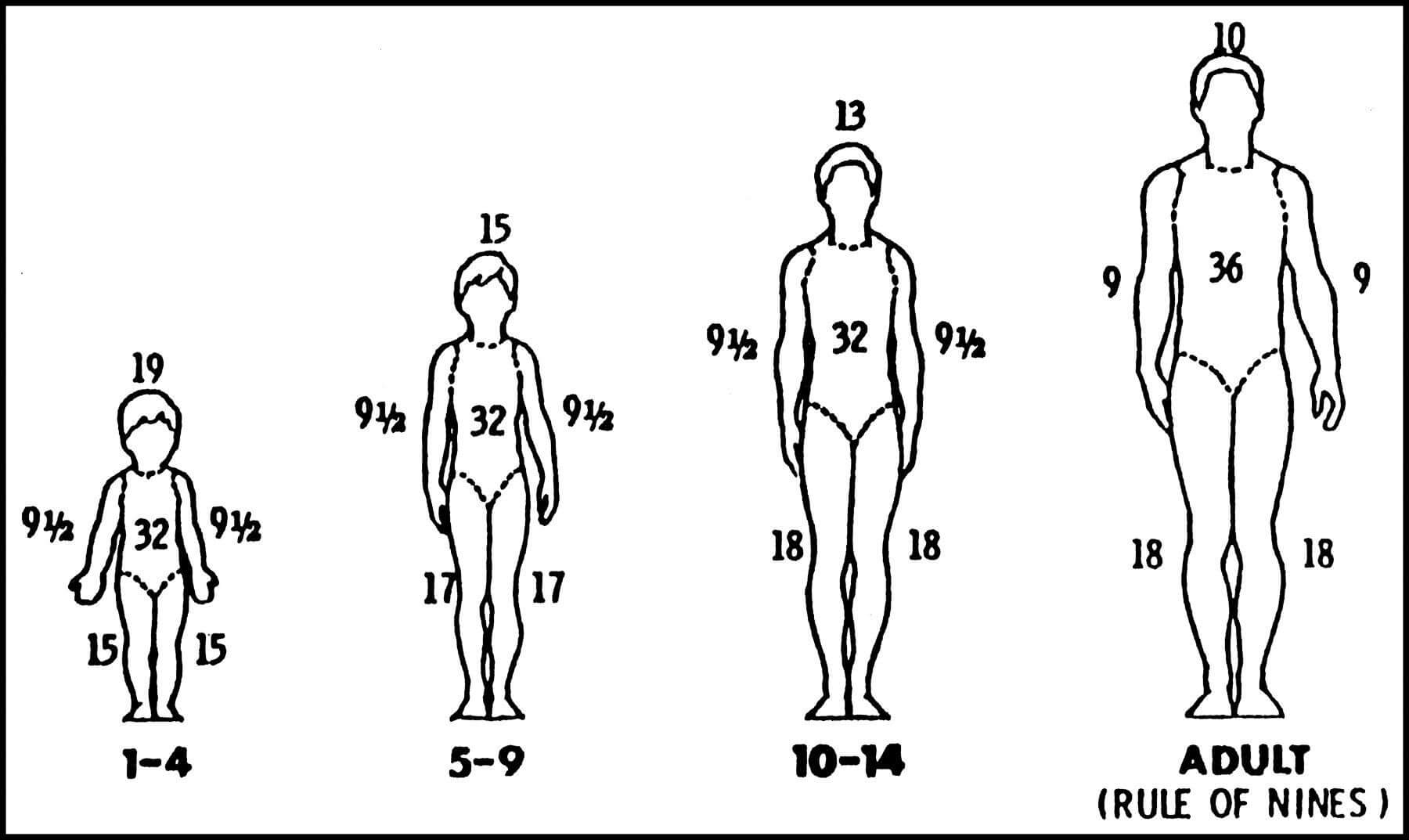
Changes to the Rule of Nine can be made according to body mass index (BMI) and age.
The Rule of Nine has proven to be the algorithm most commonly used by physicians and nurses to estimate burn surface area in numerous studies.
The Rule of Nine body surface area burnt estimate is based on assigning percentages to different areas of the body.
The whole head is estimated at 9% (4.5% front and back).
The whole torso is rated at 36% and can be further subdivided into 18% for the front and 18% for the back.
The anterior part of the trunk can be divided into the chest (9%) and the abdomen (9%).
Upper limbs account for 18% and then 9% for each upper limb. Each upper limb can be divided into anterior (4.5%) and hind (4.5%).
Lower limbs are estimated at 36%, 18% for each lower limb.
Again, this can be divided by 9% for the front and 9% for the back.
In the groin is estimated at 1%.[4][5]
Rule of Nine Function
The Rule of Nine functions as a tool for assessing second and third degree total body surface area (TBSA) in burn patients.
Once TBSA has been determined and the patient has stabilized, fluid resuscitation can often be started using a formula.
The Parkland formula is often used.
It is calculated as 4 ml of intravenous (IV) fluid per kilogram of ideal body weight per TBSA percentage (expressed as a decimal) over 24 hours.
Due to reports of over-resuscitation, other formulas have been proposed, such as a modified Brook’s formula that reduces intravenous fluid to 2 ml instead of 4 ml.
After establishing the total volume of intravenous fluids for the first 24 hours, the first half of the volume is given in the first 8 hours and the other half is given in the next 16 hours (this is converted to an hourly rate by dividing half of the total volume of 8 and 16).
The 24-hour volume starts counting from the moment of recording.
If the patient arrives 2 hours after the burn and fluid therapy has not started, the first half of the volume should be given after 6 hours and the remaining half of the fluid given according to the protocol.
Fluid resuscitation is very important in the initial treatment of second- and third-degree burns greater than 20% TBSA, as complications of renal failure, myoglobinuria, hemoglobinuria, and multiple organ failure can occur if aggressive treatment is not started early.
Mortality has been shown to be higher in patients with TBSA burns greater than 20% who do not receive adequate fluid therapy immediately after injury.
Clinicians are concerned about the accuracy of the rule of nine for obese patients and children.
The Rule of Nine is best used in patients weighing more than 10 kg and less than 80 kg if BMI defines them as less than obese.
For infants and obese patients, particular attention should be given to the following:
Obese patients
Patients defined as obese by BMI have disproportionately large torsos compared to their non-obese counterparts.
Obese patients have about 50% TBSA in the trunk, 15% TBSA in each leg, 7% TBSA in each arm, and 6% TBSA in the head.
Android-shaped patients, defined as a preferred distribution of adipose tissue in the trunk and upper body (abdomen, chest, shoulders, and neck), have a trunk that is closer to 53% TBSA.
In patients with the gynoid form, defined as a predominant distribution of adipose tissue in the lower body (lower abdomen, pelvis, and thighs), the trunk is closer to 48% TBSA.
As the degree of obesity increases, the degree of underestimation of TBSA damage to the trunk and legs increases when the Rule of Nine is followed.
Infants
Infants have proportionately large heads that alter the surface contribution of other major body segments.
The Rule of Eight is best for babies weighing less than 10 kg.
This rule assumes approximately 32% TBSA for the patient’s torso, 20% TBSA for the head, 16% TBSA for each leg, and 8% TBSA for each arm.
Despite the effectiveness of the “Rule of Nine” and its penetration into the specialty of surgery and emergency medicine, studies show that at 25% TBSA, 30% TBSA and 35% TBSA, the percentage of TBSA is overestimated by 20% compared to computer applications.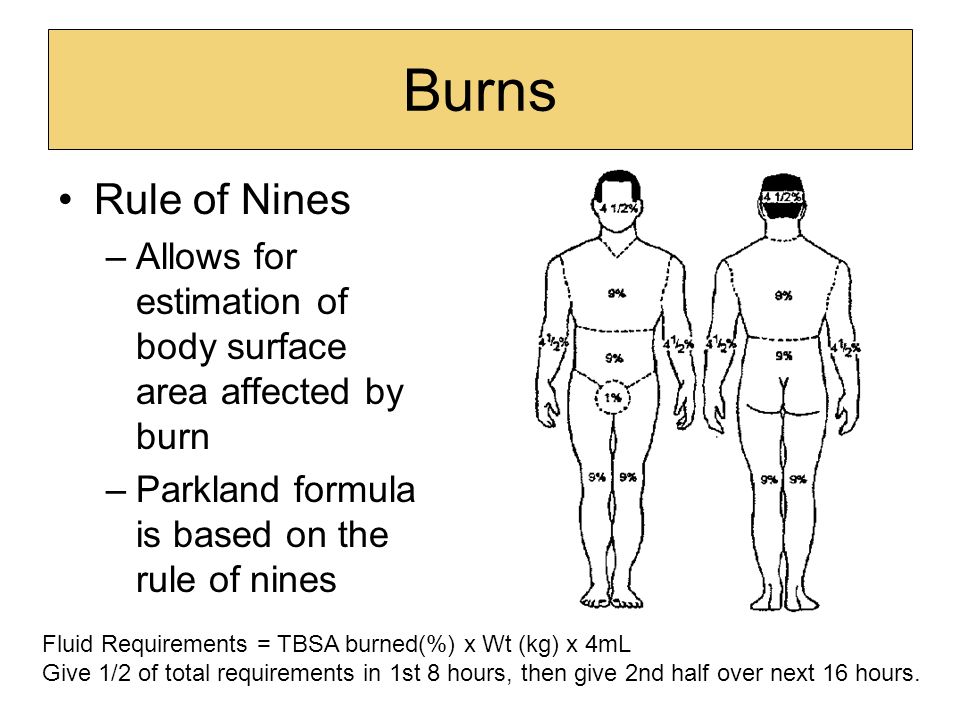
An overestimation of TBSA can lead to over-resuscitation with IV fluids, which can lead to volume overload and pulmonary edema with increased cardiac demand.
Patients with pre-existing comorbidities are at risk for acute cardiac and respiratory decompensation and should be monitored in the intensive care unit (ICU) during the aggressive phase of fluid therapy, preferably in a burn center.
The Rule of Nine is a quick and simple tool used for initial management of resuscitation in burn patients.
Studies have shown that after examining a completely undressed patient, the percentage of TBSA can be determined using the Rule of Nine within minutes.
Several studies found in the literature review state that the patient’s palm, excluding fingers, accounts for approximately 0.5% of TBSA and that the check was detected using computer applications.
The inclusion of fingers in the palm is approximately 0.8% TBSA.
The use of the palm, which is the basis on which the Rule of Nine was established, is considered more suitable for minor second and third degree burns.
It has been observed that the higher the specialist’s training, the lower the overestimation, especially for light burns.
Other issues
Due to the inherent error in human burn assessment, even when rules are set, computer applications available for smartphones are designed to minimize overestimation and underestimation of TBSA scores.
Applications use standard sizes for small, medium and overweight male and female models.
Applications are also moving towards neonatal measurements.
These computer applications experience variability in reporting TBSA scores, from overestimating up to 60% burnt surface to underestimating up to 70%.
Rule of Nine IV fluid resuscitation is only acceptable for patients with a TBSA percentage above 20%, and these patients should be transported to the nearest trauma center.
With the exception of special areas such as the face, genitals, and hands, which must be examined by a specialist, transfer to major trauma centers is only necessary for burns greater than 20% TBSA.
The American Burns Association (ABA) has also established criteria for referring patients to a burn center.
After initiation of fluid therapy, it is important to determine whether adequate perfusion, hydration, and renal function are present.
Resuscitation based on the “Rule of Nine” and intravenous fluids (among others, the Parkland method, Brook’s modification) should be carefully monitored and adjusted as these initial values are indicative.
Treatment of severe burns is a variable process that requires constant monitoring and adjustment.
Lack of attention to detail can lead to increased morbidity and mortality as these patients are in critical condition.
The Rule of Nine, also known as Wallace’s Rule of Nine, is a tool used by healthcare professionals to assess total body surface area (TBSA) in burn patients.
Measurement of initial burn surface area by medical personnel is important in assessing the need for fluid resuscitation, as patients with severe burns experience massive fluid loss due to removal of the skin barrier.
This exercise educates medical teams about the use of the “Rule of Nine” in burn victims, which will improve patient outcomes. [Level V].
References
- Cheah AKW, Kangkorn T, Tan EH, Loo ML, Chong SJ. Smartphone app test with 3D fuel burn assessment: accurate, free and fast? Burns and injuries. 2018:6():7. doi:10.1186/s41038-018-0109-0. Epub 2018 February 27 [PubMed PMID: 29497619]
- Tocco-Tussardi I., Presman B., Huss F. Want to know the correct percentage of TBSA burning? Let the non-specialist make an assessment. Journal of Burn Treatment and Research: The official publication of the American Burn Association. 2018 Feb 20:39(2):295-301. doi: 10.1097/BCR.0000000000000613. Epub [PubMed PMID: 28877135]
- Borhani-Khomani K, Partoft S, Holmgaard R. Assessment of burn size in obese adults; literature review. Journal of Plastic Surgery and Hand Surgery. 2017 Dec: 51(6): 375-380. doi: 10.1080/2000656X.2017.1310732. Epub 2017 Apr 18 [PubMed PMID: 28417654]
- Ali S.
 A., Hamiz-ul-Fawwad S., Al-Ibran E., Ahmed G., Salim A., Mustafa D., Hussain M. Clinical and demographic features of burn injuries in Karachi: six years of experience in burns Center, Civil Hospital, Karachi. Annals of burns and fires. 2016 Mar 31:29(1):4-9 [PubMed PMID: 27857643]
A., Hamiz-ul-Fawwad S., Al-Ibran E., Ahmed G., Salim A., Mustafa D., Hussain M. Clinical and demographic features of burn injuries in Karachi: six years of experience in burns Center, Civil Hospital, Karachi. Annals of burns and fires. 2016 Mar 31:29(1):4-9 [PubMed PMID: 27857643] - Volume D. Evaluation of current methods for preclinical calculation of burn size – a prehospital perspective. Burns: Journal of the International Burn Injury Society. 2017 Feb: 43(1): 127-136. doi: 10.1016/j.burns.2016.07.003. Epub 2016 Aug 27 [PubMed PMID: 27575669]
- Parvizi D., Gieretzlehner M., Dirnberger J., Owen R., Haller H.L., Schintler M.W., Wurzer P., Lumenta D.B., Kamolts L.P. Using Telemedicine in Burn Management: Development of a Mobile System for TBSA Documentation and Remote Assessment. Annals of burns and fires. 2014 Jun 30:27(2):94-100 [PubMed PMID: 26170783]
- Williams R.J., Wohlgemuth S.D. Does the “Rule of Nines” apply to morbidly obese burn victims? Journal of Burn Treatment and Research: The official publication of the American Burn Association.
 2013 Jul-Aug: 34(4): 447-52. doi: 10.1097/BCR.0b013e31827217bd. Epub [PubMed PMID: 23702858]
2013 Jul-Aug: 34(4): 447-52. doi: 10.1097/BCR.0b013e31827217bd. Epub [PubMed PMID: 23702858] - Vaughn L, Beckel N, Walters P. Severe burns, burn shock and smoke inhalation in small animals. Part 2: diagnosis, therapy, complications and prognosis. Journal of Veterinary Emergency and Critical Care (San Antonio, TX: 2001). 2012 April: 22(2): 187-200. doi: 10.1111/j.1476-4431.2012.00728.x. Epub [PubMed PMID: 23016810]
- Prieto MF, Acha B., Gomez-Sia T., Fondon I., Serrano C. A system for 3D representation of burns and calculation of the burned skin area. Burns: Journal of the International Burn Injury Society. Nov 3: 2011 (37): 7-1233. doi:40/j.burns.10.1016. Epub 2011.05.018 June 2011 [PubMed PMID: 21703768]
- Neaman KC, Andres LA, McClure AM, Burton ME, Kemmeter PR, Ford RD. A new method for evaluating involved BSAs in obese, normal weight patients with burn injury. Journal of Burn Treatment and Research: The official publication of the American Burn Association.


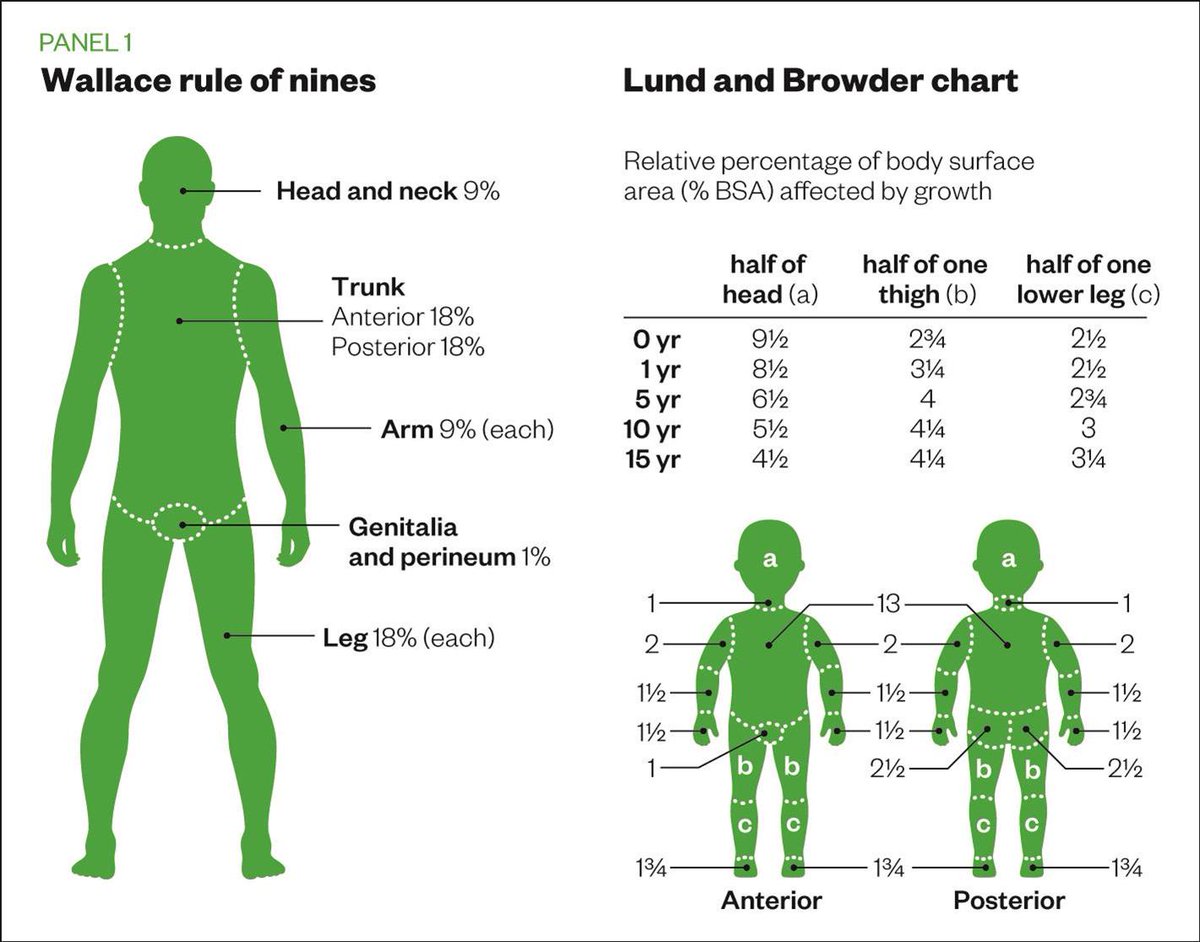
 2010.
2010.
 2022 Jun 16;5(4):e694. doi: 10.1002/hsr2.694. eCollection 2022 Jul.
2022 Jun 16;5(4):e694. doi: 10.1002/hsr2.694. eCollection 2022 Jul.
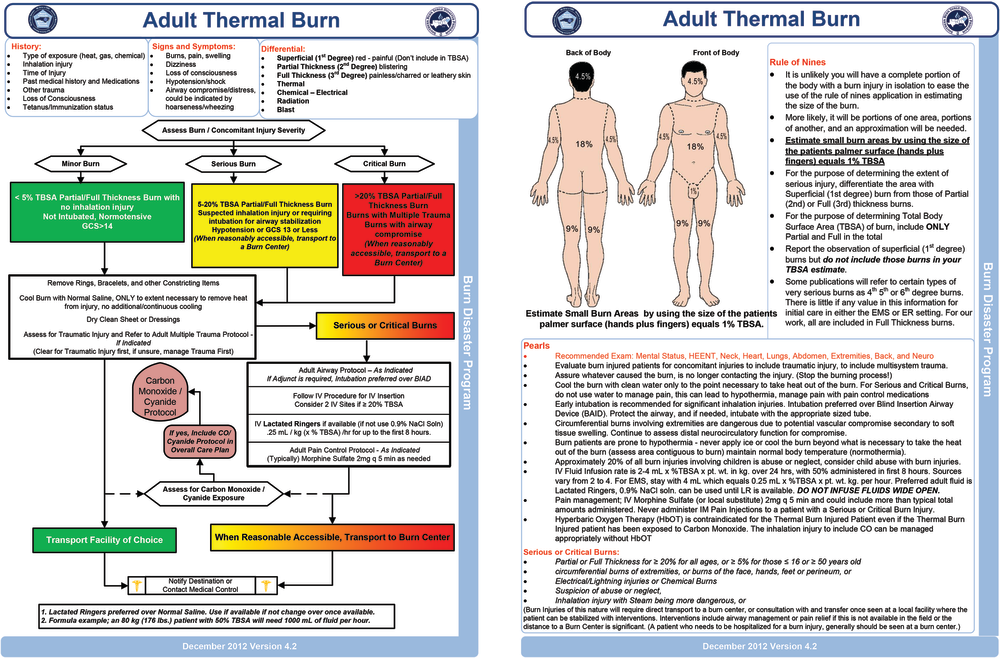






 A., Hamiz-ul-Fawwad S., Al-Ibran E., Ahmed G., Salim A., Mustafa D., Hussain M. Clinical and demographic features of burn injuries in Karachi: six years of experience in burns Center, Civil Hospital, Karachi. Annals of burns and fires. 2016 Mar 31:29(1):4-9 [PubMed PMID: 27857643]
A., Hamiz-ul-Fawwad S., Al-Ibran E., Ahmed G., Salim A., Mustafa D., Hussain M. Clinical and demographic features of burn injuries in Karachi: six years of experience in burns Center, Civil Hospital, Karachi. Annals of burns and fires. 2016 Mar 31:29(1):4-9 [PubMed PMID: 27857643] 2013 Jul-Aug: 34(4): 447-52. doi: 10.1097/BCR.0b013e31827217bd. Epub [PubMed PMID: 23702858]
2013 Jul-Aug: 34(4): 447-52. doi: 10.1097/BCR.0b013e31827217bd. Epub [PubMed PMID: 23702858]